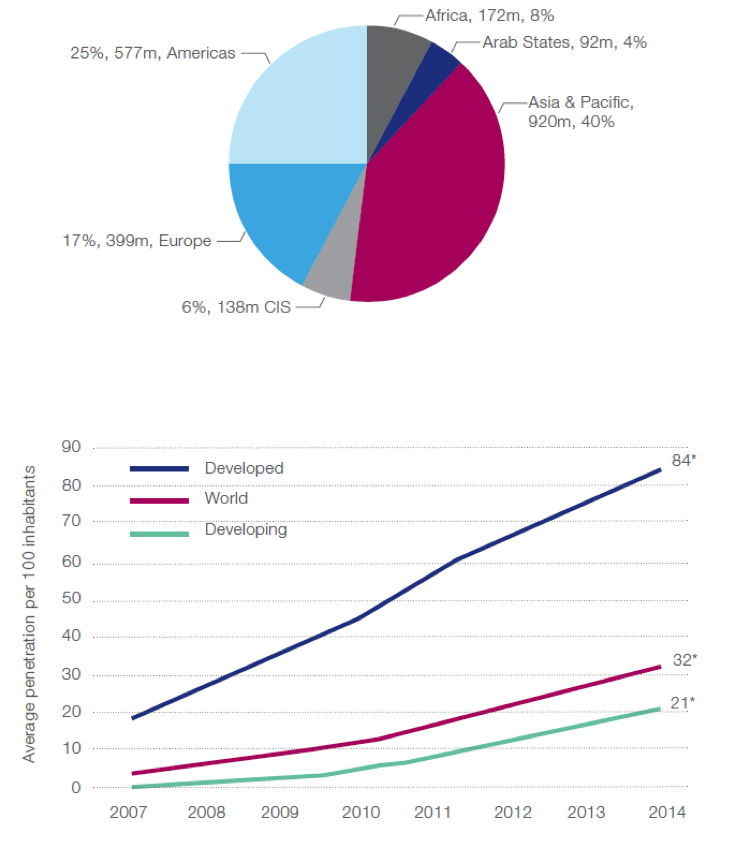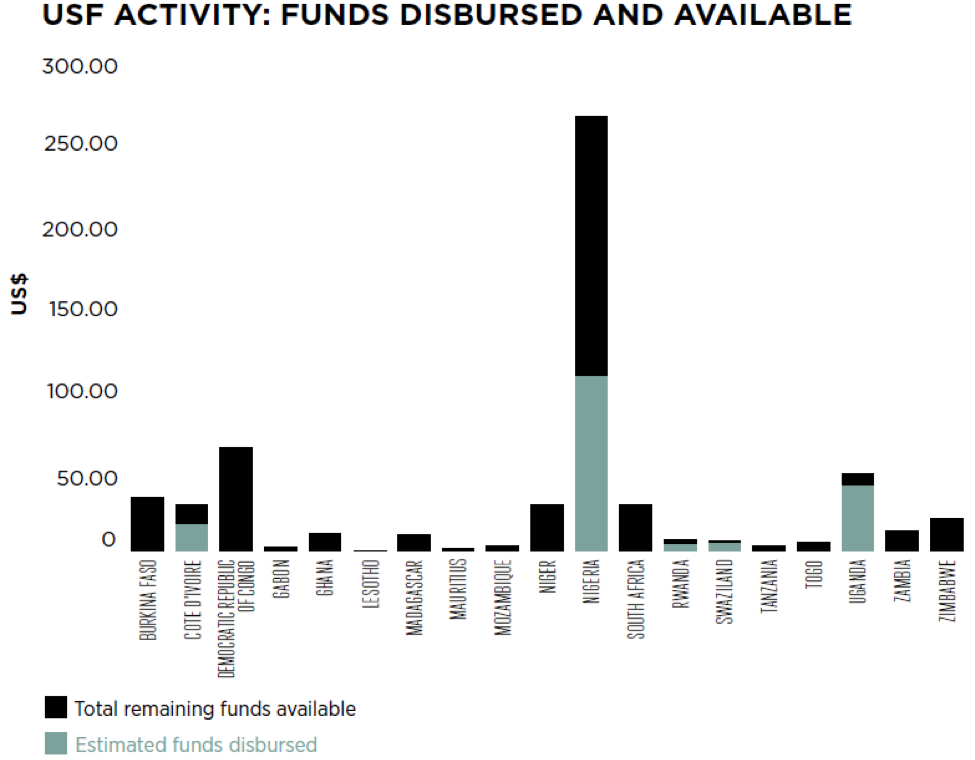Bridging the Mobile Broadband Gap
Jun 8th, 2015 by
Jose Del Rosario. NSR
Mobile broadband is no longer a “nice to have” for users
worldwide, especially as mobile device usage explodes in all regions
(just reference Cisco). However while mobile broadband demand
is undeniably ever on the rise, a divide persists between developed
and developing countries, mainly as a result of deployment costs and
business case issues. And here, Universal Service
Funds (USF) and satellite technology have a huge role to play.
ITU Data Highlights the Divide
According to the ITU/The Broadband Commission report, there gap
between developed and developing countries (in terms of mobile
subscriptions) is significant. The “32” global average is
influenced by the average penetration of developing countries, which
stands at “21” compared to “84” for developed countries. Basically,
this means there are more non-broadband subscribers in the globe
compared to broadband subscribers. And this also means that
there is a huge market waiting to be tapped to upgrade narrowband
mobile subscribers to broadband mobile subscribers.
Status of Mobile Broadband: Geographical
Distribution of Mobile Broadband Subscriptions by Region and
Evolution of Mobile Broadband, 2007-2014

Source: ITU/The Broadband Commission Report: “The State of
Broadband 2014 – Broadband for All”
Satellite wireless backhaul from a technology standpoint can
bridge this gap or tap this large market, yet satellite platforms
have been traditionally relegated to 2G and 2.5G services.
Satellite technology, which is arguably the best fit for covering
large geographic areas of developing and impoverished countries has
been and still supports basic mobile services including voice and
texting or narrowband messaging. Costs of satellite platforms
have been prohibitive in terms of addressing the low ARPU levels
that rural area customers of developing country markets can afford.
But consider terrestrial microwave and other solutions face the same
hurdles. Following pure market dynamics in bridging
the gap obviously does not work and will likely remain so over the
long term for all technology platforms.

Source: Report prepared for GSMA by Ladcomm
Corporation, September 2014
Are USFs Part of the Solution?
So the key question is - How will 3G/4G services be
enabled by regions that need it the most? Or how can this large
market potential be realized? Let’s take Sub Saharan
Africa. Although satellite technology is available to provision fast
broadband speeds, ARPU levels in rural areas do not justify
investments by mobile telcos. This situation has been
pervasive for decades; however, the answer could lie in Universal
Service Funds (USF). We say could because these funds
have been available for years, but the funds are not being spent.
According a GSMA study (note the chart above), “19
of the 23 USFs covered contained more than US$400 million waiting to
be disbursed. “
Contrast this with developed countries such as the United States
where according to the FCC, Phase I of the Connect America Fund has
authorized nearly $440 million in funding to serve over 1.66 million
previously unserved individuals in 45 states and Puerto Rico. Phase
II of the Connect America Fund aims to bring broadband service to
Americans living in rural areas lacking broadband through a
combination of wireline, fixed wireless and satellite technologies.
Moreover, in April 2015, the FCC offered the nation’s largest price
cap telcos $1.7 billion annually for six years to bring broadband to
parts of their service territories where broadband is not available
currently.
3G via satellite has arrived, and satellite players
within the mobile ecosystem are beginning to trial 4G/LTE systems as
well. Even better news is that next-generation
programs such as O3b have been launched and other offerings such as
Intelsat EpicNG will be launching soon as well. These programs
are aimed at providing services to Brownfield and Greenfield
developing country markets where the need for mobile broadband
connectivity should bridge or at least narrow the gap between
developed and developing countries.

In its latest market research report,
Wireless Backhaul via Satellite, 9th Edition
NSR forecasts satellite in-service units to move past 2G/2.5G
installations by the 2019 timeframe. By 2024, 3G/4G will be
the dominant platform being served by satellite backhaul and even 5G
solutions should be available to wireless telcos as well. The
value proposition or the “game change” being offered by HTS is to
decrease the cost of Megahertz or Mbps, thereby dramatically
improving the OPEX equation.
However, although the costs have and will continue to improve,
ROI can only be maintained with a subsidy in place. In other
words, the move from 2G/2.5G to 3G/4G/5G can only happen in
regions such as Sub Saharan Africa if USF is spent as part of a
subsidy that allows for positive ROI. HTS based purely on
market dynamics is not enough to bridge the gap.
Bottom Line
Satellites have been relegated as the last resort for connecting
users in rural, remote and far-flung areas. The business case
has not been supported or justified purely on commercial metrics due
to the low ARPU level feature of these communities. With
next-generation satellite technologies that support lower cost
structures, a business case is beginning to be built that generates
reasonable ROI for wireless telcos to go into Greenfield markets as
well as improve the service level of Brownfield or existing
customers.
However, the market dynamics and the economic outlook of
poor rural populations will not change overnight and there
are certainly other serious challenges being presented in terms of
provisioning mobile broadband services to rural communities.
CAPEX, content generation, application requirements, equipment
costs, rural electrification and other components that go into
deploying a satellite service will continue to restrain investments
and perhaps impact the mobile broadband gap at more pronounced
levels.
Next-generation programs, specifically HTS solutions, will or
should be part of the solution mix that leads to larger deployment
of mobile broadband services to the less affluent citizens of
developing countries. But that is still not enough as it is based on
pure market dynamics. USF needs to be spent and invested by national
governments on mobile programs via satellite in rural areas in order
to dramatically bridge the broadband gap. Moreover, should
Universal Service Obligations (USO) incorporate satellite solutions,
USF and USO combined should lead to a large technology and
economic stimulus that can be part of beginning to bridge the mobile
broadband gap. And that is partly how this huge market can be
realized.

